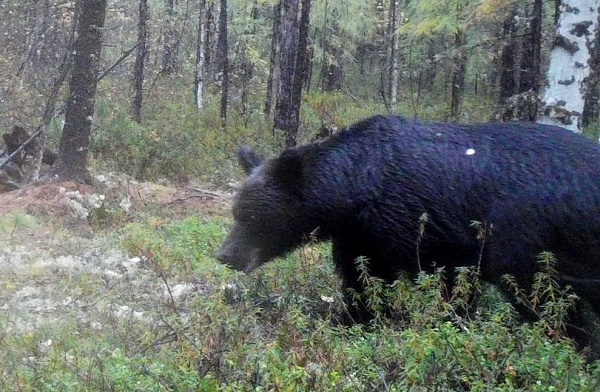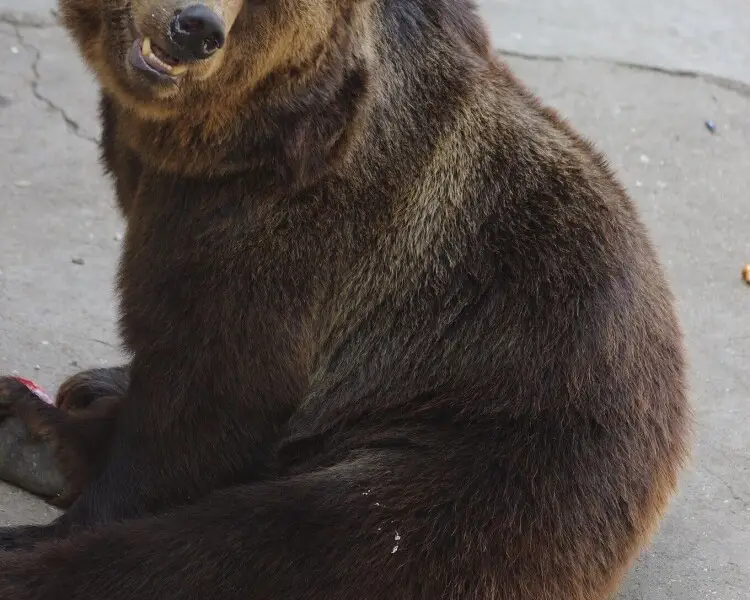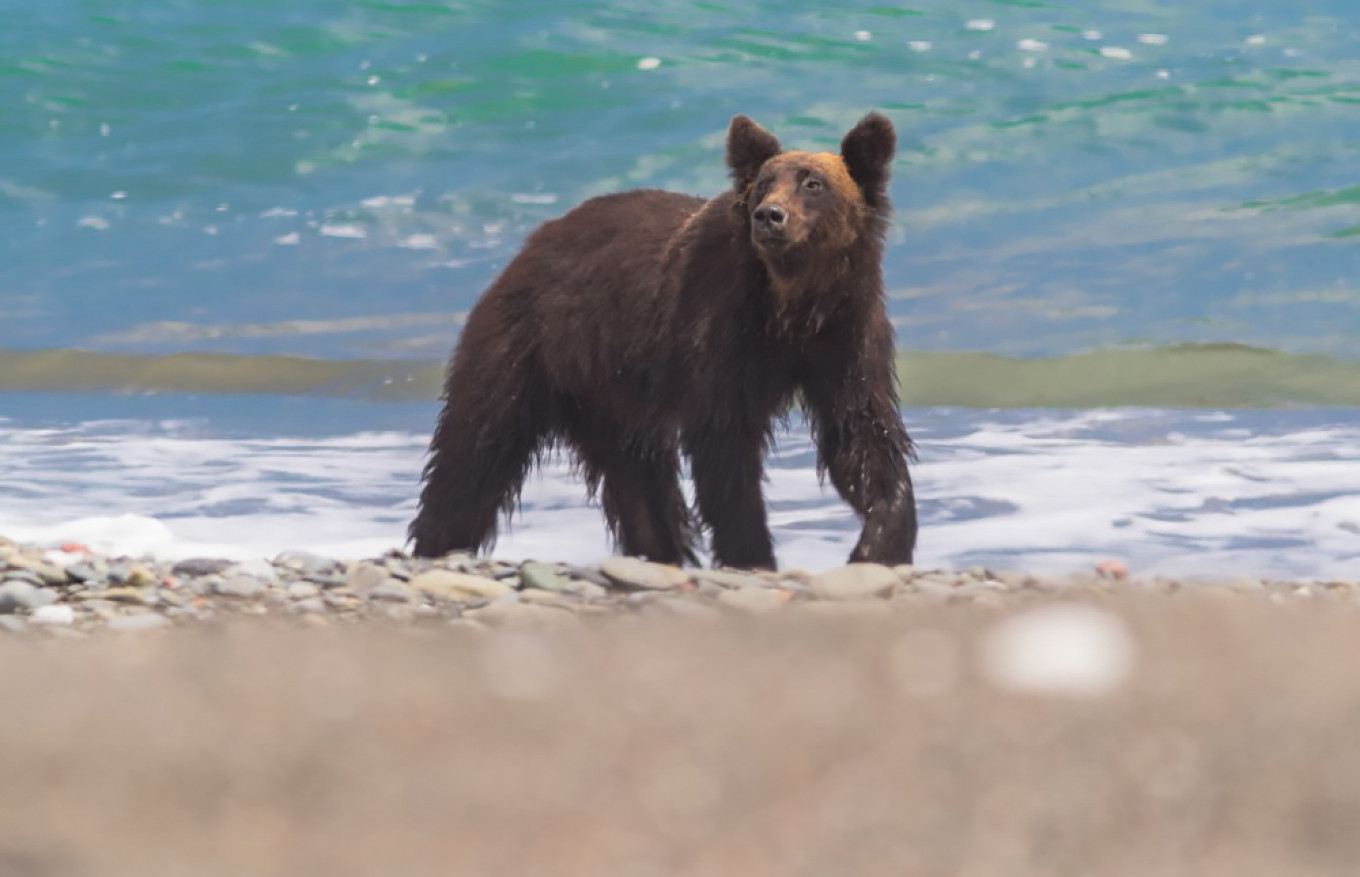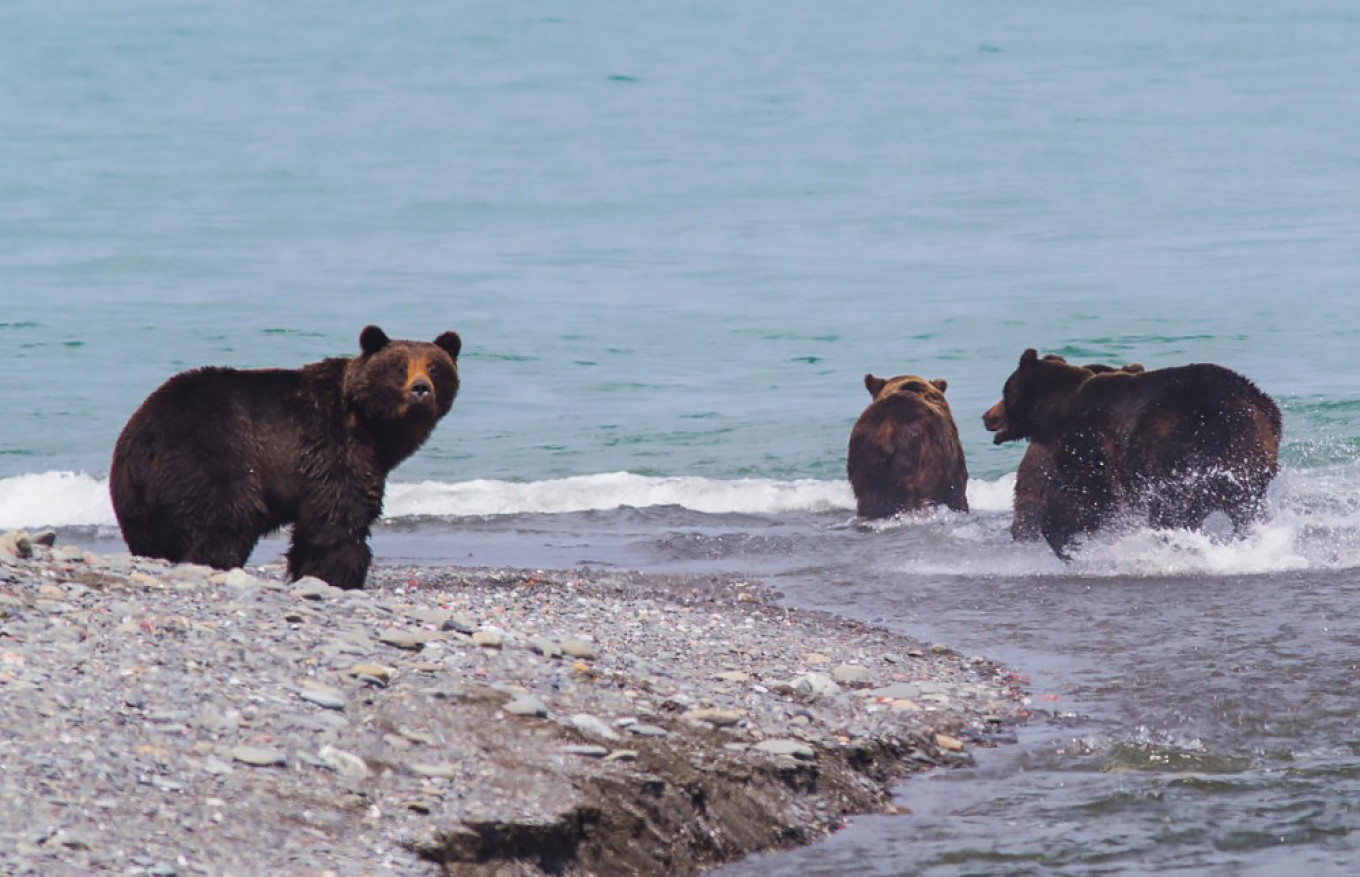|
|
Post by oldcyansilverback on Jul 3, 2022 9:05:44 GMT -5
|
|
|
|
Post by oldcyansilverback on Jul 12, 2022 6:41:48 GMT -5
 Society, 10/05/2020 09:47 Photo: FGBU "Reserved Podlemorie" Employees of the "Reserved Podlemorye" told about the "change of power" At the northernmost part of the taiga of the "Reserved Podlemorye" in Buryatia, the "owner" has changed. - We previously talked about the "owner" of the northernmost part of the taiga of the "Reserved Podlemorye", a very large and over-aged bear. Camera traps registered his presence in the lands within a radius of about 10 km, but in the summer season of this year he no longer appeared on the set, - said senior researcher Gennadiy Yankus. At the same time, more often than others "posed" a handsome bear in a fur coat of almost black color. Based on his physique, he is middle-aged. This bear has diligently marked the trees along the many paths. - And on a twilight September morning, we managed to observe how he, with a formidable roar, chased along the shore of Lake Baikal after another bear, who risked a profit from a seal thrown onto the sand by a storm. Other inhabitants of the taiga, it seems, humbly did not notice the "change of power". Well, this is just a moment of a natural process, - concluded Gennady Yankus. www.baikal-daily.ru/news/16/400035/wildfact.com/forum/topic-russian-brown-bears?pid=135310#pid135310 |
|
|
|
Post by oldcyansilverback on Jul 14, 2022 19:27:53 GMT -5
Hokkaido's endangered bears keep their cool with DHL en route to Yorkshire Wildlife Park
- Group of four bears to their new home 9,000 km away - Variety of temperature-control measures, including 10 degrees Celsius trucks, kept the bears from climate-related stress throughout the journey TOKYO, Aug 5, 2018 - (Media OutReach) - Four of Hokkaido's endangered Ussuri brown bears - Riku, Kai, Hanako and Amu - have safely migrated to their new home in the United Kingdom's Yorkshire Wildlife Park, transported with utmost care during the 9,000km journey by DHL Global Forwarding, the leading international provider of air, sea and road freight services.  The endangered Ussuri brown bear, also known as the black grizzly bear The endangered Ussuri brown bear, also known as the black grizzly bear, is found in many regions in the world but they are extinct across parts of Asia. Reported to be 10,000 left in Japan, the bears are on the IUCN Red List of Threatened Species due to their vulnerability to habitat loss, illegal hunting and capture, and being poached for body parts and skins. Each Ussuri brown bear can weigh up to 550kg and requires temperatures to be maintained as closely as possible to their native climate in northern Japan and Korea.[1] As such, purpose-built crates that could fit into the aircraft were produced for each of the bears to ensure they were comfortable throughout the trip. Moving from Hokkaido, the bears' voyage saw them travel via special temperature-controlled trucks chilled to 10 degrees Celsius for the journey to the New Chitose Airport in Hokkaido. From the Hokkaido airport, they were flown to Haneda Airport in Tokyo, Japan, where they boarded a connecting flight to Heathrow Airport, London. A veterinarian and an animal handler travelled alongside the precious cargo, as maintaining a safe and comfortable environment for the bears was of paramount importance. "Any shipment of live animals, particularly those with such unique needs as the Ussuri brown bears, requires extensive planning and collaboration between various parties," said Charles Kaufmann, President/Representative Director - Japan K.K and CEO, North Asia, DHL Global Forwarding. "We're proud to be able to play a critical role in bringing to bear our full set of competencies, from rapid multimodal freight to customs clearance of sensitive cargos, in relocating these four magnificent creatures to their new world-class home, along with the team at Yorkshire Wildlife Park. Having our own offices at both the New Chitose and Haneda airports, as well as a dedicated temperature-controlled 10-ton truck required for this project, enabled us to provide an ideal solution for this intricate operation." DHL Global Forwarding worked closely with the Park to plan and orchestrate the complex voyage, optimizing and customizing transport routes and modes respectively. The company also provided expedited customs clearance for the bears' arrival in London while Park staff managed final leg of the journey from the airport to their new home. The bears, ranging from 17 to 27 years old, will spend the rest of their lives in the care of expert handlers at Yorkshire Wildlife Park, a world leader in endangered species welfare which also hosts one of the largest polar bear conservation projects in the world.[2] The park and its Foundation support conservation and welfare projects all around the world - from the critically endangered Amur leopard in Russia, the black rhino in East Africa to the lemurs of Madagascar. "Spacious, temperature-controlled environments were a necessity for the bears' welfare along the voyage," said John Minion, CEO, Yorkshire Wildlife Park. "DHL took utmost care to ensure the animals arrived with as little stress and risk to their health as possible - no mean feat for such a lengthy and complex journey. The bears will be the first residents in a new Rehabilitation Centre at the Park - a 2.5-acre specialist reserve which has been designed for short to mid-term housing of carnivores who have been rehomed - before moving into their permanent home at the Park. We are excited to prepare the bears for their new home where they will receive the lifelong care they need." DHL - The logistics company for the world DHL is the leading global brand in the logistics industry. Our DHL family of divisions offer an unrivalled portfolio of logistics services ranging from national and international parcel delivery, e-commerce shipping and fulfillment solutions, international express, road, air and ocean transport to industrial supply chain management. With about 360,000 employees in more than 220 countries and territories worldwide, DHL connects people and businesses securely and reliably, enabling global trade flows. With specialized solutions for growth markets and industries including technology, life sciences and healthcare, energy, automotive and retail, a proven commitment to corporate responsibility and an unrivalled presence in developing markets, DHL is decisively positioned as "The logistics company for the world". DHL is part of Deutsche Post DHL Group. The Group generated revenues of more than 60 billion euros in 2017. www.acnnewswire.com/press-release/english/45249/hokkaido%27s-endangered-bears-keep-their-cool-with-dhl-en-route-to-yorkshire-wildlife-parkEdit: Posted the rest of the article  .
|
|
|
|
Post by oldcyansilverback on Sept 21, 2022 23:29:02 GMT -5
Ussuri brown bear.  The Ussuri brown bear, also known as the Ezo brown bear and the black grizzly bear, is a subspecies of the brown bear or population of the Eurasian brown bear . One of the largest brown bears, a very large Ussuri brown bear may approach the Kodiak bear in size. It is not the same subspecies as the grizzly bear. animalia.bio/ussuri-brown-bear |
|
|
|
Post by brobear on Sept 26, 2022 10:24:57 GMT -5
Q: What is the typical HB length of the Amur/Ussuri/Manchurian Brown Bear (Ursus arctos lasiotus)? Q: What is the typical HB length of the Amur/Siberian tiger (Panthera tigris altaica)? *Note: full-grown males of course.  |
|
|
|
Post by Gorilla king on Sept 26, 2022 10:43:04 GMT -5
|
|
|
|
Post by Gorilla king on Jan 12, 2023 18:48:50 GMT -5
Daily activity patterns of brown bear (Ursus arctos) of the Sikhote-Alin mountain range (Primorskiy Krai, Russia)
Abstract and Figures
Daily activity patterns of brown bears were monitored using radiotelemetry from 1993 to 2006, in the Sikhote-Alin Biosphere Reserve and adjacent areas. Outside of the denning period, bears were active for approximately 52% of the 24-hour period. Males were more active (64% of total time) than females (51%). Brown bears in the Sikhote-Alin are diurnal and crepuscular, but switch to a nocturnal pattern in areas of high anthropogenic influence. During the summer months, daily activity patterns were influenced by precipitation, cloud cover, and air temperature.
www.researchgate.net/publication/257859027_Daily_activity_patterns_of_brown_bear_Ursus_arctos_of_the_Sikhote-Alin_mountain_range_Primorskiy_Krai_Russia
|
|
|
|
Post by Gorilla king on Jan 13, 2023 17:38:24 GMT -5
|
|
|
|
Post by oldcyansilverback on Jan 23, 2023 4:25:35 GMT -5
The Ussuri brown bear is larger than all brown bear subspecies except the Kamkatcha brown bear (can be comparable in size), Peninsula Alaskan brown bear, and Kodiak bear.
|
|
|
|
Post by Gorilla king on Jan 28, 2023 20:21:37 GMT -5
|
|
|
|
Post by oldcyansilverback on Feb 10, 2023 20:20:42 GMT -5
|
|
|
|
Post by Gorilla king on Feb 10, 2023 21:59:02 GMT -5
|
|
|
|
Post by oldcyansilverback on Feb 10, 2023 23:30:42 GMT -5
/\ My reason for guessing: brown bears on the isolated island seems to be heavier on average. The 1320 pound male Ussuri brown bear might be the ‘Van’ of all brown bears regardless.
|
|
|
|
Post by Gorilla king on Feb 12, 2023 14:59:54 GMT -5
|
|
|
|
Post by Gorilla king on Apr 14, 2023 21:37:20 GMT -5
S.P. Kucherenko (2003)
Вследствие слабой развитости медвежьих охот на юге Дальнего Востока в послевоенные годы здесь до последнего времени встречаются старые, а потому и очень крупные медведи. К сожалению, мы в дополнение к коллекции черепов не имеем квалифицированных промеров тела тех медведей-гигантов, однако приведем проверенные сведения, подтвержденные квитанциями приема туш на заготпунктах промхозов. Так, в ноябре 1958 г. Братья Федоренко в верховьях Большой Уссурки добыли зверя, весившего без внутренностей, лап и шкуры 470 кг. А.П. Плешанков в ноябре 1966 г. на реке Перевальной убил медведя, вес которого без внутренностей составил 437 кг. Живой вес этих двух медведей вряд ли был меньше 600 кг. У добытого С.С. Соломонюком на реке Аввакумовке самца очень жирная туша без лап, внутренностей, шкуры и головы весила 506 кг. Живой вес этого экземпляра не мог быть меньше семи центнеров. Череп убитого Соломонюком самца имеется в нашей коллекции, и он в ней не самый крупный (табл. 1). Можно предполагать, что более массивные черепа (табл. 3) принадлежали медведям, весившим при осеннем ожирении в урожайные годы до 800 кг, возможно и больше. Для иллюстрации сказанного приводим в качестве сравнения основные промеры наиболее крупных черепов бурого медведя из различных регионов страны (табл. 2).
О размерах уссурийских медведей можно судить и по замеренным отпечаткам лап (без когтей). В ноябре 1962 г. в верховьях Мухена встречались очень четкие свежие следы (в см): задняя лапа 22,5 х 36 см, ширина передней – 24. В 1966 г. в верховьях Бикина замерен след 22 х 35 и 24 см соответственно, в 1967-м на р. Аввакумовке – 21 х 34 и 23, в 1972-м на р. Тырме – 20 х 31 и 22, в 1975 г. на р. Каранак – 23 х 36 и 25 см. Используя таблицу соотношения длины тела и размеров оттисков лап, можно рассчитать, что приведены следы медведей, имевших длину тела до 270 -280 см.
Due to poorly developed bear-hunting in the Far East in the postwar years, until recently, there are old and therefore very large bears. Unfortunately, we have, in addition to the collection of skulls do not have a qualified body measurements of the Bears-Giants, but give the information verified, validated receipts for receiving carcasses zagotpunktah promhozov. So, in November 1958 Brothers Fedorenko in the upper Great Ussurka extracted beast, weighing no viscera, feet and skin 470 kg. AP Pleshankov in November 1966 on the river saddle killed the bear, whose weight without viscera was 437 kg. Live weight of the two bears are unlikely to be less than 600 kg. At the extracted SS Solomonyukom River Avvakumovke male is very oily carcass without feet, viscera, skin and head weighed 506 kg. Live weight of this instance could not be less than seven quintals. Skull of the murdered male Solomonyukom available in our collection, and it is not in it is the largest (Table 1). We can assume that the more massive skull (Table 3) belonged to the bears, in the autumn vesivshim obesity in good years to 800 kg, and possibly more. To illustrate this give a comparison of the basic measurements of the largest brown bear skulls from different regions of the country (Table 2).
About the size of the Ussuri and the bears can be seen from the measured paw prints (without claws). In November 1962 in the upper Muhena met very clear signs of recent (in cm): hind foot 22.5 x 36 cm, width of the front - 24. In 1966 the upper Bikin measured trace 22 x 35 and 24 cm respectively, in 1967, at p. Avvakumovke - 21 x 34 and 23, 1972, at p. Tyrma - 20 x 31 and 22, 1975 at p. Karanak - 23 x 36 and 25 cm using the table of the relation of body length and size of prints of paws, one can calculate that shows signs of bears, who had a body length of up to 270 -280 cm.
|
|
|
|
Post by Montezuma on Apr 16, 2023 2:28:24 GMT -5
"Populations of both species (Brown bears and black bears) have been increased in 2018 by 10%-15%". 
"A multi-year database of bear images also allows for monitoring the impact of poachers on wildlife, estimating the proportion of affected animals and thus the intensity of poaching. Bears are large, strong predators, capable of escaping from a looping trap, from which the smaller, pain-sensitive, the smaller, pain-sensitive leopard would be unable to break free. So, bears can be indicators of the influence of poachers on rare animal populations in an area shared habitat. Scars caused by metal loops serve as good individual markers for identifying specific individuals bears. For example, a large adult female with 5 cubs has a scar from a loop trap, which allowed us to clearly distinguish her and her brood for three years."
|
|
|
|
Post by Gorilla king on Apr 16, 2023 7:26:15 GMT -5
Reply #35:
That is a very good find there bro. Anyways, i had a feeling since long time ago that leopards are "pain sensitive", ha ha ha.
|
|
|
|
Post by Gorilla king on May 1, 2023 18:19:49 GMT -5
USSURI BROWN BEAR FROM SAKHALIN ISLAND

Many scientists would classify the Sakhalin population as a distinct sub-species. The animals on Sakhalin are overall similar to the Kamchatka bears and reach 500 kg and more, the skull is more elongated and the skull arches are not as wide.
The color varies from straw to black. Bear seasonal activity In the spring, when they emerge from their dens, a majority of bears head for the coastal zone. During the first half of April, all along the Southern coast of Sakhalin (and in the North at the end of April-early May), snow is melting and at the same time the snow on the upper belt of the coastal terraces under the forest cover can reach between 1 and 1.5 meters.   www.themoscowtimes.com/2019/07/27/up-close-with-the-bears-of-sakhalin-in-russias-far-east-a66586BASIC DIET OF THE SAKHALIN BEARS: www.themoscowtimes.com/2019/07/27/up-close-with-the-bears-of-sakhalin-in-russias-far-east-a66586BASIC DIET OF THE SAKHALIN BEARS:
|
|
|
|
Post by Gorilla king on May 1, 2023 18:27:29 GMT -5
 Record Ussuri brown bear, Sakhalin island, October, 2005. Record Ussuri brown bear, Sakhalin island, October, 2005.
Skull measurement: GSL: 18 5/16 inch,
GSW: 10 6/16 inch.
Score: 28 11/16 inches. |
|
|
|
Post by oldcyansilverback on May 3, 2023 15:34:19 GMT -5
|
|